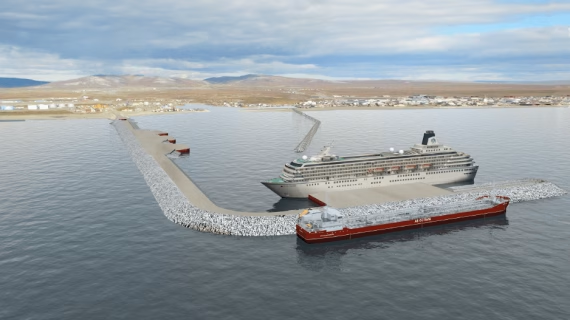In a landmark move toward enhancing U.S. Arctic infrastructure, the U.S. Army Corps of Engineers (USACE) has awarded Kiewit Infrastructure West Co. a $399.4 million contract to launch Phase 1A of the Port of Nome Deep-Draft Navigation Project. This transformation will establish Nome as the country’s first deepwater port above the Arctic Circle. It also presents sweeping implications for local communities, national security, and the evolving Arctic economy. The award also builds on Kiewit’s expanding portfolio of critical infrastructure projects across the U.S. This inlcudes its recent selection as construction manager for the $800 million I-55 bridge replacement in Illinois, highlighting the company’s capacity to deliver complex, high-value works.
A Deeper Look: What the Project Entails
Structural Expansion: On the agenda: a 1,200-foot extension of the causeway, 600 feet of additional dock, and a new 40-foot deep-water basin, enabling cruise liners, cargo ships, and nearly every U.S. military vessel (save aircraft carriers) to dock directly in Nome.
Timeline: Construction is slated to begin in summer 2026, with expectations to finish by 2029, marking decades of planning and overcoming earlier procurement setbacks.
Project Factsheet
Project: Port of Nome Deep-Draft Navigation, Phase 1A
Contract Value: $399.4 million (USACE)
Lead Contractor: Kiewit Infrastructure West Co.
Key Features: 1,200-ft causeway extension, 600-ft dock, 40-ft basin
Start–End Date: Summer 2026 to 2029
Strategic Importance: Arctic climate resilience, shipping, and defense
Community Role: Resupply, tourism, mineral exports, local arts
Concerns: Cultural impact, subsistence disruption, ecosystem risks

Strategic Stakes: Climate, Commerce, and Security
Climate as Catalyst: Arctic sea ice retreats approximately one to three weeks later than it did 50 years ago. This trend is steadily opening previously frozen shipping corridors. Nome’s deeper port could become a pivotal Arctic maritime hub.
Economic Lifeline: The expansion promises greater affordability and efficiency in shipping vital supplies, fuel, food, building materials, to over 60 remote Alaskan communities, along with bolstering fishing, tourism, and mineral exports. Miner Graphite One, for example, plans to ship its ore via Nome once the port is deepened.
Geopolitical Edge: As Russia and China increase their naval presence in the Arctic, the U.S. is modernizing its northern logistics infrastructure. Alaska hosts deployed fighter jets, and the expanded port will strengthen Arctic defense capabilities.
Voices from Nome and Beyond
Mayor John Handeland hailed the contract as years in the making, a win not just for Nome, but for Alaska’s broader future: “After decades of skepticism, it’s finally happening.”
Port Director Joy Baker detailed the project’s transformative potential, noting that it “supports resupply, community safety, scientific outreach, and critical economic lifelines” across western Alaska.
Community & Environmental Considerations
A Mixed Reception: While some Inupiaq residents welcome the economic promise, others express concerns over environmental impacts and cultural shifts brought by increased commercial activity. Local artist and guide Alice Bioff hopes expanded traffic will benefit indigenous creators. While critics caution against disruption of subsistence areas and potential ecological degradation. By weaving together climate realities, regional livelihoods, defense needs, and indigenous voices, this article offers a 360° view of what the Port of Nome expansion truly represents, far beyond mere construction. That multi-angle richness and its strategic resonance can help your coverage outperform standard summaries in search rankings.

